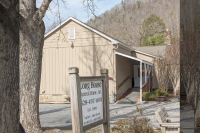Horseshoe Rock phenomenon attracts writers’ attention
 “As for the Horseshoe Rock, it is one of those curving balds of solid rock. The depressions found on the rock are quite a curiosity, because of their great number, uniform size, and arrangement in long straight rows running parallel close together and at regular intervals; in fact, everything about them is so regular as to border on the supernatural …. One can visualize a herd of ponies coming up Horseshoe Rock from below by leaping past its more perpendicular part and then riding on in military formation abreast of one another to the top where they vanish in thin air.”
“As for the Horseshoe Rock, it is one of those curving balds of solid rock. The depressions found on the rock are quite a curiosity, because of their great number, uniform size, and arrangement in long straight rows running parallel close together and at regular intervals; in fact, everything about them is so regular as to border on the supernatural …. One can visualize a herd of ponies coming up Horseshoe Rock from below by leaping past its more perpendicular part and then riding on in military formation abreast of one another to the top where they vanish in thin air.”
— T.W. Reynolds, High Lands (1964)
As a collector of books about Western North Carolina, I am curious about the authors and the places they write about. Horseshoe Rock, a granite outcrop at 4,000 feet in the remote northeastern portion of Jackson County, has been visited and written about by at least three authors. Those would be me; T.R. Reynolds, the eccentric Highlands local historian and adventurer; and Faith Hunter, author of paranormal fantasies like Skinwalker in her “Jane Yellowrock” series, which features a full blooded Cherokee woman who happens to be is a hunter of rogue-vampires.
Reynolds’ books include High Lands (1964); Born of the Mountains (1964); Cherokee and Creek (1966); and The Southern Appalachian Region (Hitherto Untold Stories) 2 vols. (1966). He was at times cranky when describing his adventures, and he wasn’t the finest prose stylist this side of Wilma Dykeman; nevertheless, he wrote from direct experience.
Having read about Horseshoe Rock in High Lands, it wasn’t long before I decided to visit the place myself. That was in the fall of 2001. At 4,000 feet the morning air was brisk. Gray mist swirled up out of the valleys obscuring distant vistas. But I was not disappointed. The outcrop exposure was much more expansive than anticipated. Indeed, the contiguous cliffs form a huge horseshoe-like curve on the eastern front of Wolf Mountain.
The ancient “hoof prints” are clearly etched into the rock strata.
Related Items
There are numerous high-elevation granitic domes and rock faces in Western North Carolina, including Sunset Rock overlooking downtown Highlands that display similar features. But as Reynolds noted, the ones at Horseshoe Rock are perhaps unique in regard to their linear patterns.
As to the origins of the “hoof prints,” Reynolds consulted various “authorities on such matters. One of those was of the opinion that the depressions were created — like potholes in a stream — by the circular erosion of sand in water. But water flow on the summit of the dome would have been of insufficient volume and force to create the depressions via granular erosion. A “lightning expert” advised that small depressions “collect water, which attracts lightning” that makes larger depressions.
The correct answer — albeit less dramatic than lightning strikes — was supplied by the state geologist for North Carolina, who replied to the Reynolds’ query as follows:
“Your description and sketches indicate that the depressions are the result of weathering. As the weather acts on the rock, some portions being less resistant, and others, more so, the less resistant are moved away by various processes, including solution, thus leaving the depressions behind.”
In geology texts, these depressions are defined as “weathering pits” or “solution pits.” They form where certain minerals weather more rapidly than others. Accordingly, the “weathering pits” on Horseshoe Rook were formed like a linear series “hoof prints” by the chance deposition of ancient minerals.
Faith Hunter, a native of Louisiana reportedly living in South Carolina, has obviously spent some time in Western North Carolina and has actually visited Horseshoe Rock.
Hunter is a prolific writer of fantasy, paranormal, and thriller novels. These are genres I don’t normally follow, but I chanced upon her work when I googled up “Horseshoe Rock.” One of her many series of novels and stories is devoted to a character named Jane Yellowrock, who has no memory of her life or family before she was 12 except for “a granite mountain” that had been “pitted by tears.”
Having researched the Internet, she determined that the most likely site to recover her past self and her lost family was “Horseshoe Rock in Jackson County, North Carolina in the Nantahala National Forest.” So she journeyed to WNC on her trusty dirt bike (what else?) and “took State Road 281 through the hills” until she “spotted a sign that said “Wolf Mountain Road.”
The next day she returned and located Horseshoe Rock, “where standing in the lowering clouds, their mist snaking over the ridge into the valley below, I looked out over the world below. Horseshoe Rock was bigger than I could remember … bigger than anything I could ever remember seeing. Yet it was familiar. I had been here before. Several … no. Many times before.”
So there you go. Three entirely different writers (counting me) latched onto the same spot for entirely different reasons: historical, journalistic, and novelistic. I haven’t been back to Horseshoe Rock — but, if I do, I’ll be surprised if I don’t find those hoof prints in stone right where I left them 15 years ago.
(George Ellison is a naturalist and writer. He can be reached at This email address is being protected from spambots. You need JavaScript enabled to view it..)









